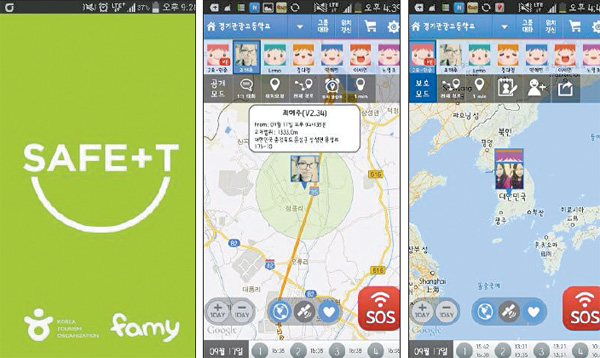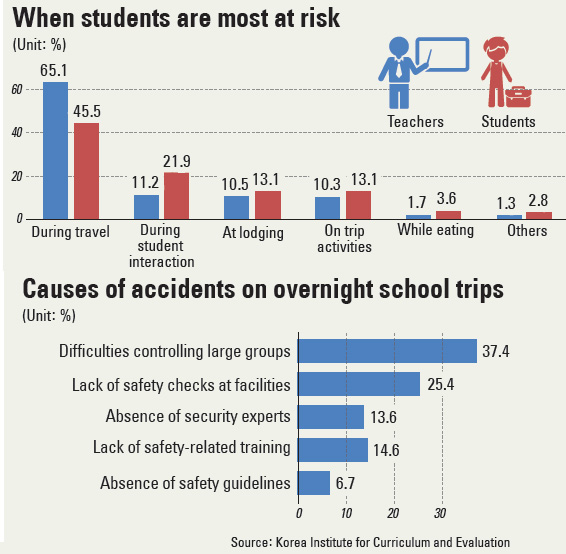After Sewol, calls to overhaul class trips

Gyeonggi Tourism High School students tour the inside of Lotte Hotel Busan as part of their school trip last week. Provided by the Korea Tourism Organization
The question has been a bone of contention among teachers, parents and students since the tragic sinking of the Sewol ferry that killed around 250 of 325 Danwon High School pupils and teachers who were on their way to Jeju Island in April.

Screenshots of a mobile application that will help teachers locate students on a school trip. The app comes out next month. Provided by the Korea Tourism Organization
And since the Ministry of Culture, Sports and Tourism announced new guidelines in July, it is now up to schools to decide whether they will resume the extracurricular trips.

The state-run Korea Tourism Organization (KTO) has come up with ways to make overnight trips safer and more educational so that students can still spend time with friends outside of their daily routines.
Instead of just visiting popular tourist spots with their entire class, the KTO proposes that schools take small groups of students to industrial sites where youngsters can see professionals working in certain job fields and receive career advice.
“Going on a class trip is a crucial part of an educational curriculum to encourage students to form a sense of being a part of a community whilst they develop an autonomous thinking process,” said Byun Choo-suk, CEO of Korea Tourism Organization.
“Of course it will take time, but we will continue to search for ways that can fulfill expectations from [parents, students and teachers.]”
However, even with attempts to save school trips, many industry experts remain skeptical of acting on the advocated measures as it costs more money to organize smaller trips, which puts a heavier burden on students and parents.
In addition, local travel agencies do not yet have diverse models to present to schools for smaller trips, as not many educational institutions or government offices related to tourism have collected data to work with, according to Kim Jong-pil, president of OK Edutour, who has been arranging school trips for almost two decades.
Problem spotting
The sinking of the Sewol ferry sparked a review on how school trips are conducted in Korea for the first time since they began in 1914.
The tradition was launched in the early 1900s to give students a chance to travel as opportunities to do so rarely came in a country with an industrial revolution and rapid economic growth, which required parents to spend long hours at work.
A lack of infrastructure also made it difficult for pupils to take short day trips if they wanted to visit places outside of their neighborhoods.
“When such a tradition of going on a class trip in a group started, it was inevitable that such trips were large in size due to organizational difficulties and an inconvenient public transportation system,” said Lee Kwang-ho, a professor of Youth Studies at Kyonggi University.
“Also, going on a trip somewhere far away was meaningful for students because taking a family vacation was not a popular idea for many reasons, including financial ones.”
Some experts argue that scrapping school trips in Korea is premature, favoring restructuring instead to focus on safety and education.
“Many parents have opposed school trips and there are movements online to completely scrap them, but we think it is more essential to fix things instead, adding safety measures and educational value,” said the National Association of Parents for Charm-Education in a press release.
“Going on an overnight class trip is a very meaningful part of the educational curriculum because students can take a break from their tight class schedules set up towards entering a college and as it can be a chance for students to show their talents that never get to be revealed at school.”
Trips with themes
As a model for future trips, the Korea Tourism Organization helped one school plan an unforgettable class tour last week to Busan and nearby Tongyeong in South Gyeongsang.
The public tourism body focused on giving the trip educational value by taking students at Gyeonggi Tourism High School to see how major hotel chains work and what job positions are available at them.
The pupils visited Lotte Hotel Busan, which hosts international business travelers and leisure tourists.
After a quick tour of the hotel, the pupils watched a presentation on possible careers and prerequisites for working in the travel sector before being given the chance to ask questions.
“For me personally, touring around the hotel was more fun than another school trip to a green tea farm,” said Lim Hye-ri, a student at the school.
“Seeing what I normally don’t get to see in everyday life was fun.”
Recreation time during the evening was also geared toward learning. The students gathered to participate in a quiz on safety and emergency evacuation training they had undertaken before and during the trip.
To keep the group entertained between questions, some of the teenagers gave K-pop performances they had practiced ahead of time.
While the trip in Busan focused heavily on checking out business facilities, including the Bexco convention center, students got to enjoy a little history on their last day in Tongyeong.
Following the popularity of the recently released movie “The Admiral: Roaring Currents,” the high school decided to make the most of an opportunity to teach students about the historical figure Adm. Yi Soon-shin by visiting places related to him.
“The trip is to set a model that school trips can be diversified based on students’ interest,” said Kim Jeong-ah, the director of the Korea Tourism Organization’s National Tourism Welfare Team.
“We hope more schools get to develop other models in the future so that more students get to build memories with friends.”
Cutting costs
Taking less students per trip - with below 100 being the recommended number - has become a popular idea after the Sewol disaster so that teachers can keep a closer eye on students’ whereabouts.
But school principals with experience arranging such vacations say local travel agencies avoid working with smaller tour groups because they make more money with larger groups.
“Since travel agencies work on [commission], they prefer to host large groups,” said Shin Yong-uook, the principal of Gyeonggi Tourism High School.
Shin added that it is inevitable for the cost to rise per person if a school rents a 50-person bus and fills it with just 30 students.
In the end, it is the students and their parents who are burdened with the higher costs.
“I doubt if trends can change sooner so that trips can proceed smoothly in every aspect regarding arranging transportation, lodging and eating,” Shin said.
“It is necessary for the tourism industry and schools to work on developing new programs so that we can have some sustainable models for everyone.”
There have been discussions about developing travel programs targeting a smaller number of students in the past as many teachers have complained about the stress of large-group arrangements. But a lack of enthusiasm from the travel industry impeded change.
“The most regretful thing is that we cannot decide details on making such school trips better just with aspects that touch on educational values,” said Professor Lee, adding that local educational ministries have been recommending smaller-size groups but that the tourism industry does not have the adequate facilities to cater to them.
“Because such trips lie in the extension of the tourism industry that is connected with companies that provide bus rides, lodging, and other things, we cannot just solely and simply prioritize students’ safety and other educational values.”
Additional help
Regardless of opinions in favor or against the cancelation of school trips, particularly overnight, many agree that Korea has neglected safety measures in this field.
Teachers and students worry more about getting into accidents while traveling by road, rail or air rather than during trip activities, according to a survey by the Korea Institute for Curriculum and Evaluation in June. Teachers are expected to respond quickly in emergencies on trips yet safety training or guidelines have been severely lacking.
In addition, critics point out that there are simply not enough teachers to continuously check safety measures while taking care of students.
Schools now turn to trained professionals to check safety measures on trips who ask students to buckle up when getting on the bus, inform students about emergency evacuation in auto accident and do head counts to make sure no one is left behind.
During last week’s trip, teachers at Gyeonggi Tourism High School were assisted by safety experts from the private company Wiz-L and retired firefighters recruited by the KTO.
Having assistance has lifted a great deal of pressure off teachers.
“It was nice to have more time to talk to students about what they learn during the trip and how they are enjoying themselves rather than getting crazed with head counting students whenever we get to places,” said Kim Mun-kyum, a teacher at the school.
Some teachers also said they got to sleep a couple hours extra while security personnel helped to supervise the trip at night.
Usually, one security official takes care of 20 students, although the number of students in their charge varies from one company to another. On this trip, a total 13 safety experts accompanied about 100 students.
Although convenient, the cost of the added help does not come for free. Principal Shin admitted that while it is nice to have help, he is not sure that the school could afford to use the same service again.
Students paid 150,000 won ($143) for the three-day trip, but the Korea Tourism Organization supplied another 150,000 won per pupil for the extra safety measures.
Digitally connected
To resolve financial issues, the Korea Tourism Organization is in a process of launching a mobile application that students, teachers and parents can use to stay connected on school trips.
The app will help locate students, and whenever teachers need to deliver an announcement, they can simply send a message. Parents can use it to follow the trip’s trajectory.
In case of emergencies, the “SOS” button on the app will call nearby police and fire stations so that students in need will get help right away.
Pupils will also get the chance to find more information about the destinations they are heading to within the app as affiliated travel agencies will provide this type of information.
The app will be updated after feedback is given from the Gyeonggi Tourism High School trip. It will be launched officially next month.
BY LEE SUN-MIN [summerlee@joongang.co.kr]










with the Korea JoongAng Daily
To write comments, please log in to one of the accounts.
Standards Board Policy (0/250자)